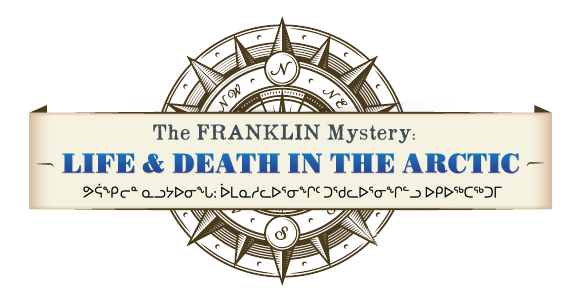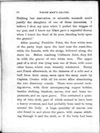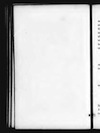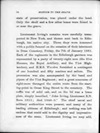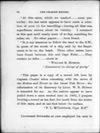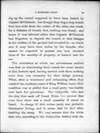Inuit take Schwatka to Crozier's camp, Irving's Grave and find evidence of Hobson and McClintock's visit (1882)
After passing Franklin Point, the four white men of the party kept upon the land near the coast-line, while the Innuits, with the sledge, followed along the shore ice. Before reaching Collinson Inlet, they fell in with the graves of two white men. The upper part of a skull was lying near one of them, with some other bones, which were decently reinterred. Henry and Frank afterwards, at the distance of a mile and a half from their camp, came upon the camp made by Captain Crozier with all his crews after abandoning the two discovery vessels. There were several cooking-stoves, with their accompanying copper kettles, besides clothing, blankets, canvas, iron and brass implements, and an open grave. This contained a quantity of blue cloth, part of which seemed to have been a heavy overcoat, and had probably been used to wrap around the body. A huge quantity of canvas was also found in and about the grave, with coarse stitching through it and the cloth, as if the body had been encased for burial at sea. Several gilt buttons lay among the rotting cloth and mould in the bottom of the grave, and a lens, apparently the object-glass of a marine telescope. Upon one of the stones at the foot of the grave Henry found a medal thickly covered with grime. It was of silver, two and a half inches in diameter, with a bas-relief portrait of George IV., encircled by the words -
GEORGIUS IIII D.G. BRITANNIARUM
REX. 1820.
on the obverse; and on the reverse a laurel wreath surrounded by -
SECOND MATHEMATICAL PRIZE,
ROYAL NAVAL COLLEGE
and enclosing the words -
AWARDED TO JOHN IRVING.
MIDSUMMER, 1830.
This relic at once identified the grave as that of Lieutenant John Irving, third officer of the Terror. A figured silk pocket-handkerchief, neatly folded, the colours and pattern of which were in a remarkable state of preservation, was placed under the head. Only the skull and a few other bones were found in or near the grave.
[...]
The day after this discovery, Lieutenant Schwatka moved his camp to the vicinity of the dead officer's last resting-place, and spent two days in searching round about, but ineffectually at that time, as the snow still covered the ground. But when they returned there from Cape Felix, on the 11th of July, they found the snow nearly gone and the ponds near the shore almost all dried up. Accordingly they renewed their search, and with more success. Among the various articles that rewarded their labour was a brush with the name "H. Wilks" cut in the side, a two-gallon stone jug stamped "R. Wheatly, wine and spirit merchant, Greenhithe, Kent," several tin cans, a pickle bottle, and a canvas pulling strap, a sledge harness marked with a stencil plate "T 11," showing it to have belonged to the Terror.
On their second visit, Toolooah's wife discovered in a pile of stones a piece of paper which, mirabile dictu, had weathered the Arctic storms of thirty years. It proved to be a copy of the Crozier record found by Lieutenant Hobson of the McClintock expedition, and was in the handwriting of Sir Leopold McClintock. The document was written with a lead pencil on notepaper, and was partially illegible from exposure. It was literally as follows:-
"May 7, 1869.
"Lat. 69° 38' N., long. 98° 41' W.
"This cairn was found yesterday by a party from Lady Franklin's discovery yacht Fox, now wintering in Bellot Strait......a notice of which the following is......removed:-
" '28th May 1847.
"'H.M. ships Erebus and Terror wintered in the ice in lat. 70° 05' N., long. 98° 23' W., having wintered at Beechy Island in lat. 74° 43' 28" N., long. 91° 39' 15" W., after having ascended Wellington Channel to lat. 77°, and returned by the west side of Cornwallis Island.
"'Sir John Franklin commanding the expedition. All well. A party of two officers and six men left the ships on Monday, the 24th May.
"'Graham Gore.
"'Charles F. Des V......"
"......into a......printed form, which was a request in six languages that if picked up it might be forwarded to the British Admiralty."
Round the margin of this paper was -
"'"'The 25th April 1848
"'H.M. ships Terror and Erebus were deserted on the 22nd April......opens to the N.N.Wd. of this, having been beset since 12th Sept. 1846. The officers and crews, consisting of 105 souls, under the command of Captain F. M. Crozier, landed here in lat. 69° 37' 42" N., long. 98° 41' W.
"'This paper was found by Lieutenant Irving under the cairn supposed to have been built by Sir James Ross in 1831, four miles to the northward, where it had been deposited by the late Commander Gore in June 1847. Sir James Ross's pillar, however, has not been found......the paper has been transferred.......this position, which......was erected.
"'Sir John Franklin died on the 7th of June 1847, and the total loss by deaths in the expedition has been......officers and fifteen men.
"'F. M. CROZIER,
Captain and Senior Officer.
"'JAMES FITZJAMES,
Captain H.M.S. Erebus.
"'And start to-morrow for Back's Fish River.'
"At this cairn, which we reached.....noon yesterday ; the last cairn appears to have made a selection of your (?) for travelling — leaving all that was superfluous strewn about its vicinity. I remained at this spot until nearly noon of to-day, searching for relics, etc. No other papers......been found.
" It is my intention to follow the land to the S.W., in quest of the wreck of a ship said by the Esquimaux to be on the beach. Three other cairns have been found between this and Cape Felix They contain no infor......about it.
" William R. Hobson,
" Lieutenant in charge of party."
"This paper is a copy of a record left here by Captain Crozier when retreating with the crews of the Erebus and Terror to the Great Fish River : the information of its discovery by Lieut. W. R. Hobson is intended for me. As the natives appear to have pulled down a cairn erected here in 1831, I purpose burying a record at ten feet due north from the centre of this cairn, and at one foot below the surface.
"F. L. McCLINTOCK, Capt. R.N."
Lieutenant Schwatka at once employed his men to dig up the record supposed to have been buried by Captain McClintock; but though they dug a deep trench four feet wide from the centre of the cairn, due north, for a distance of twenty feet, nothing was found ; and hence it was inferred either that Captain McClintock had forgotten to deposit the record, or that changes in the surface of the ground had revealed it — in which case it may have been stolen by the Innuits, who cannot be expected to possess any very elevated ideas of the sanctity of property, or washed into the sea.
The conclusion at which our adventurers arrived was, that on abandoning their vessels the crews landed at this historic spot, having carried with them nothing more than was necessary for their sledge journey. When, after a wearisome and exhausting effort, they reached the southern coast of King William Land, their condition was so pitiful that a small party was hastily sent back for provisions. The Ookjoolik, who saw the ship that sank off Grant Point, has proved that even then there was a small quantity of stores on board. In charge of this return party was probably Lieutenant Irving, and it seems that he died after reaching the camp. We may assume that the white men who, according to the Ookjooliks, drifted with the ship to the island off Grant Point, also belonged to this party, and, with the true sailor's instinct, preferred to stick to the ship rather than crawl back to the famishing party which they had left, with scarcely any better prospects, on the south coast. From the appearances of the boat place at Erebus Bay, it may be conjectured that the hapless vessel floated ashore after the débâcle of the ice, having previously been deserted by all who were able to walk. That skeletons were discovered in the boat by those who saw it before it was gradually destroyed, as well as by Schwatka's party, is a proof, we fear, that at the time the whole company were reduced to an extremity ; otherwise we may be sure that the helpless would never have been forsaken.

